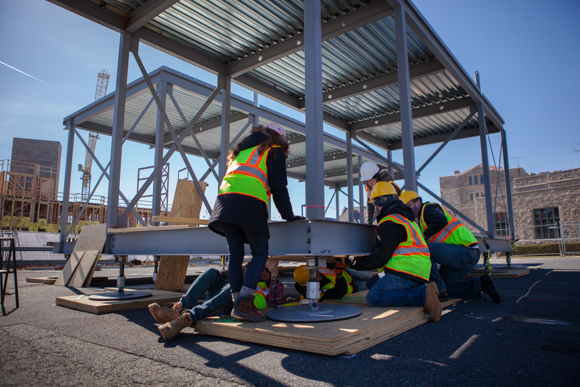A team of students from three universities in the District will be the first to represent the nation's capital in the U.S. Department of Energy's Solar Decathlon next fall, which — as luck would have it — will for the first time not be held in D.C.
Instead, after conceiving, designing and building a concept home that produces all the energy it needs, the team will have to transport it some 3,000 miles to Irvine, Calif., where the competition will be held.
Kyle Noell, an architectural graduate student and leader of the Team Capitol DC project, says he doesn't mind losing the home-court advantage. At least students who participate in the competition won't be expected to attend classes between building the structure and waiting for judges to scour it (they'll take about 900 measurements of things like energy-efficiency and climate control over 10 days to determine a winner).
The team consists of about 100 students from The Catholic University of America, The George Washington University and American University. While engineering students from GWU and architecture students from Catholic design the building, film students from American are making a documentary about the project and spreading the word.

The team was among just 11 new teams accepted to the 6th biennial competition, which garnered a record number of applications, and is the first to feature only D.C. universities. They will compete internationally with 19 other collegiate projects, many of them from larger universities.
With the project heading into its home stretch, D.C. residents can see the fruit of students' work right now as the home is being built at the Catholic University campus.
Noell says the D.C. team also has an advantage in building the structure here first before transporting it to its final, desert-like destination. If the students can make the house's solar and HVAC components work in D.C.'s humid and finicky climate, "we should have no problem in California."
"We want to win the competition," Noell says. "We were expecting to be the home team, but we want to bring the trophy back here."
The concept
Team DC's concept is for an 800-square-foot house that will harvest everything its residents need from the environment through solar panels, rainwater collection and edible plants in the yard. The house will take advantage of natural cooling and ventilation with well-placed windows that will reduce the need for air conditioning. The team even collected reclaimed floorboards for the home from a recently demolished nearby church that dated from 1844.
Elements like these will help the team's score in ten categories of the competition (hence the term "decathlon"), which include market appeal, energy balance and engineering. Noell says an added focus on this year's competition is affordability, with teams encouraged to keep the cost of their structures around $300,000.
"The next wave of sustainability ... isn't just putting solar panels on a building but creating a whole home."
Bill Jelen, an architecture professor at Catholic University overseeing the project, says this factor especially prepares the students for the real world, as they work to not only meet the demands of a competition but of customers with budget constraints.
"The students are getting exposed to the next wave of sustainability, which isn't just putting solar panels on a building but creating a whole home," says Jelen, who, as the principal of a local architecture firm, is one of many industry professionals helping the students.
The District students are not just planning to win the competition. They are creating the home with a military veteran in mind and hope to find a recipient in California to whom they can cater the home's advanced features.
"The idea is that [the house] would be given to a veteran organization or an actual veteran at some point. It's been something ingrained in our project from the beginning, knowing they've given up things for us," says Noell.
A home recently installed for two families in D.C.'s Deanwood neighborhood was the
fruit of a past Decathlon competition. Students from The New School in New York City and the Stevens Institute of Technology in Hoboken, New Jersey designed the home and shipped it across the Anacostia River to be installed by Habitat for Humanity.
The commitment
The project has been a nearly full-time job for student leaders like Noell, who is working on master's degrees in architecture and science and sustainable design (all at once).

Noell says the experience has been more than worthwhile — and is likely to help him land a job after graduation, hopefully in the D.C. area. He grew up in Maryland and sees several opportunities in the market here. "I love the area and the opportunities in this area," he says.
"In today's market, architecture in particular is hard," he adds. "Because you can say you're working on a project of this nature, most of the students get job offers on site."
The public will be able to view the D.C. project during construction on Catholic University's campus and, with a little airfare to California, during public viewing days at the competition, Oct. 3-13, 2013.
Learn more about the DC team at teamcapitoldc.org and about the Decathlon at solardecathlon.gov.